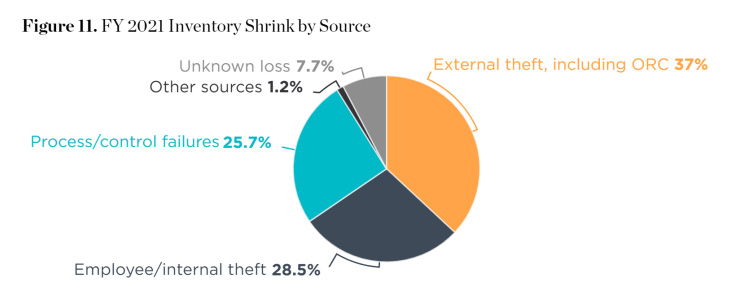Inventory shrinkage is the difference between a product’s recorded stock count and the amount physically on hand. The difference between these two amounts is referred to as “shrink.” In a retail setting, it is also sometimes called retail shrink. Either way, both mean the same thing—you’re missing inventory you thought you had.
You can use our shrinkage calculator below to determine the shrinkage your business is experiencing. And continue reading to learn how to calculate shrink by hand, review the causes and impacts of retail shrink, and explore ways that you can prevent loss in the future.
Shrinkage Calculator
Input your recorded inventory and actual inventory counts to see just how much shrinkage your business is experiencing.
How to Calculate Inventory Shrinkage
Retail shrink can be measured in two ways: in units and as a percentage. A unit measure will tell you the actual number of units you have lost, and a percentage will tell you what share of your inventory has been lost. Typically, shrinkage as a unit is used to measure the loss of a single product, while shrinkage as a percentage is used to measure loss across your entire inventory.
Acceptable retail shrink rates typically fall between 1% to 2%, with the industry average landing at 1.4% in 2021. While 1.4% might seem like a low value, this amounted to over $94.5 billion in losses that year.
To get an accurate count of your inventory and its shrinkage, you must track your inventory levels continuously. You can download and use our free Inventory Management Workbook to create a system that will work for you, or you can check out our suggestions for the best retail POS systems to automate the process.
Download our Free Inventory Management Workbook
Causes of Shrinkage in Retail
In general, there are three main causes of retail shrink: shoplifting, employee theft, or clerical errors. Here we will look at all three causes of inventory shrinkage so you can understand how they work.

This figure from the National Retail Federation’s 2022 Retail Security Survey shows the significant contributions of all three causes to retail shrink, with external theft taking the highest share. (Source: NRF)
Shoplifting

Shoplifting and other forms of nonemployee theft account for the most significant amount of retail inventory shrink.
Shoplifters target vulnerable and unobserved areas in your store. The spaces between aisles and racks, dressing rooms, and quiet corners are places thieves will strike.
For example, when I managed retail spas, aestheticians locked their products after finishing treatments and before leaving the room. Before we started that practice, it was common for customers to slip skincare products into their purses or pockets when redressing after a treatment.
Businesses that sell high-value, high-demand products are often targeted by shoplifters. Additionally, stores that sell small items, like decor or cosmetics, are also more vulnerable.
Tag swapping is a version of shoplifting and another pervasive form of retail shrink that affects inventory numbers and profits directly. Tag swappers place a lower-priced item’s tag on a higher-priced product and then complete the purchase. This strategy hides the theft initially, but it throws inventory numbers off for both goods. Unfortunately, most retailers detect this during stock counts―long after the fact.
Other types of customer theft, such as coupon scams or online fraud, also affect your profits and bottom line but aren’t necessarily revealed as missing units. You can spot this type of loss by examining sales figures and discount reports—this is where using a robust POS system comes in handy.
You should also be aware of organized retail crime, or ORC, a phenomenon that has been on the rise for several years. Essentially, organized retail crime is professional shoplifting, or any theft that occurs with preplanning and as part of a larger group. An individual acting alone is not considered organized retail crime.
Organized retail criminals move from store to store and even city to city, committing theft in an organized manner. Typically, ORC involves a group of individuals stealing merchandise that they then convert to cash via online auction sites, at flea markets, or even to other retailers.
Employee Theft

Employee theft can be difficult to detect and mitigate but should be addressed to avoid shrinkage from this source.
Although employee or internal theft is the exception and not the norm, the cost of only one dishonest employee on average is $1,551.66. Unfortunately, internal theft can be tough to spot and remedy. Since employees have access to extended areas of the store and know sales and inventory control processes, it’s easy for untrustworthy staff to steal goods under the radar.
Did you know?
More than 58% of retailers have reported an increased risk of employee theft since the start of the pandemic, with 15.5% reporting a major increase.
Marking sellable goods as damaged, stock receipt miscounts, sliding items to friends during checkout, and applying excessive discounts are some of the ways internal theft takes form. Later, we will look at some of the ways you can deter employee theft, from making a pleasant work environment to installing access controls.
Clerical Errors

Even the best businesses face clerical errors when managing their inventory.
Stock control and clerical errors are other common causes of retail shrink. Some errors might be as simple as miscounts and do not reflect physical losses. Others can be costly, such as recording all of the goods in a supplier shipment as “received in full” when some items were actually missing from the shipment.
Clerical errors can also create a false sense of inventory shrinkage because they result in an inaccurate picture of your actual inventory counts. For example, if you thought that you had 120 units of a shirt and recorded it as such, but then you really only had 100 units and lost none, you would falsely believe that your shrinkage rate was near 17%.
We will go into more detail below, but the best way to mitigate recording errors is to automate your inventory management with a POS system wherever possible.
According to the 2022 National Retail Federation Security Survey, 60.3% of stores are boosting their investment in retail technology to mitigate shrink.
Impacts of Inventory Shrinkage
Inventory shrinkage might seem trivial but it can have a massive impact on your business. Explore the impacts of shrinkage in retail below.
- Excess inventory: If you run out of an item due to shrinkage, you may assume that the item sold well, so you should order it in higher quantities. In the long run, this can lead to excess inventory or even liquidation—converting unsellable goods into cash—if your sales forecasting gets skewed.
- Loss of revenue: Inventory that is lost to shrink yields no profit and leaves you with a negative net profit for the product in question. If shrinkage occurs on a large scale, this revenue loss can amount to thousands of dollars each year.
- Loss of trust: Part of running a successful retail business is creating a positive work environment for your staff and a friendly and inviting shopping experience for your customers. If you are continually losing products to shrink and have no mitigation against it, you will start to lose trust in your staff and customers, ultimately infecting both the work and shopping environment with distrust and ruining experiences.
- Increased prices: If shrink is cutting into your bottom line, you will have to pick up the slack somewhere, and that somewhere will likely be the price of your products.
- Stockouts: Your inventory management system can only account for products that you sold, not those that were lost to shrink. This means that shrink will make you think you have less merchandise than you think, which can ultimately lead to stockouts and dissatisfied customers.
- Higher operating costs: Shrink can lead to all sorts of operating issues when it comes to inventory and staff management, and this, in turn, can cause you to make bad inventory decisions and to have to invest in different solutions to keep your products safe. This, plus the revenue lost from retail shrink, causes operating costs to be higher, especially when compared to overall profits.
How to Prevent Retail Shrink
So, it is clear that inventory shrinkage is happening and that it impacts retailers’ bottom lines and overall performance. But what can you do about it? Consider the strategies below for preventing shrink due to shoplifting, employee theft, and clerical errors.
Shoplifting Prevention Tips
As mentioned earlier, theft is the top driver of retail shrink and can affect your bottom line drastically. In fact, in 2022, among only 26 major retailers, there were over 295,654 shoplifter apprehensions worth $237 million in recovered goods. This is over a 50% increase in shoplifter apprehensions over 2021.
Here are some of the ways you can prepare your business for shoplifters and deter them from taking your goods.
- Optimize your store layout: When planning your retail store layout, position your checkout near your store’s entry, so that you and your staff can see every person that comes and goes. If that’s not possible, at least make sure that there is a clear line of sight from your cash wrap to the exit.
- Use mirrors, signs, and cameras: Don’t be afraid to let customers know you’re watching them. Honest customers won’t care, and the precaution will make thieves wary. Security mirrors and video cameras can be placed strategically so that you can watch over areas that are hard to see from the checkout and other staffed areas. Add a few signs letting people know that they are being watched.
- Secure expensive goods: Take extra steps to protect your expensive goods with secure cases or by placing them close to watchful eyes. Your register or other areas where staff members are always present are great places to merchandise your most valuable items.
- Install a security system: Security systems allow you to keep watch over your store, sound alarms, and get alerts if something were to happen. We recommend SimpliSafe, which is an affordable option with 24/7 monitoring, customizable program options, app-based controls, and a proven ability to effectively save businesses money.
- Educate and train staff: Train your staff to look out for any suspicious behavior and report it without hesitation. They should pay attention to what merchandise goes in and comes out of dressing rooms. During checkout, you can also train your clerks to spot-check that purchased bags are empty and that tags correctly match the items. Note, however, that you should never encourage staff to do anything that might jeopardize their safety.
- Tag products with security tags: A security tag is a special plastic tag that can only be removed with a special tool and will damage the product otherwise. Additionally, many set off sensors if a theft tries to remove a product from the store with the tag still attached. If a thief thinks the product they want to steal is going to light up the security monitors on their way out, they are less likely to take it.
For more info on these tips and others, check out our articles on retail loss prevention tips and tips for retail theft prevention.
Employee Theft Prevention Tips
Employee theft is a frustrating topic and often uncomfortable to broach. However, every retail store owner eventually comes across a less-than-honest employee. And even otherwise loyal staff sometimes push the limits by stacking discounts or giving employee discounts to friends.
Did you know? Among 26 major retailers, there were 44,834 dishonest employee apprehensions in 2022, up 18.0% over 2021, and these apprehensions allowed these retailers to recover over $50 million in revenue.
Here are some ways to protect your business from less-than-upstanding staff:
- Screen your candidates: The best way to prevent employee theft is to hire honest staff in the first place. Increased employee screening has been adopted by more than a quarter of retailers to help fight inventory shrinkage from internal theft. Run background checks, such as those done by GoodHire, follow up with references, and incentivize employee referrals to grow a strong team.
- Require employee logins: A POS system that supports unique staff logins gives business owners a powerful tool to prevent employee theft-related inventory shrinkage. It allows you to see detailed reports on which staff members handle receipts, sales, inventory adjustment, returns, and applied coupons to sales. You can also use staff logins to limit staff access to only the systems and areas they need to get their job done.
- Conduct regular audits: Audits comparing sales and inventory reports with physical stock are great for detecting shrinkage. Doing so regularly will make it easier to track down the source of any discrepancies. Audits deter employees from engaging in theft and make stealing much more difficult to get away with. They are also essential for being sure that your accounting is accurate and there are no discrepancies between your records and your actual inventory. An inaccurate picture of your stock can lead to bad inventory decisions and inaccurate reporting.
- Place cameras in employee-only areas: In addition to using cameras on the sales floor to deter shoplifting, don’t hesitate to use video cameras in your store’s backroom and break, storage, and receiving areas. Employees have access to many out-of-the-way spots in your store, and that’s where theft generally occurs. Review footage regularly to ensure staff is not taking advantage of their employee privileges.
- Use checks and balances: Stock counts and receiving tasks are opportunities for dishonest staff to hide theft within inventory adjustments and stock receipts. Having a two-person system for stock checks and receiving creates more accountability and makes it harder for dishonest employees to steal.
- Create a positive work environment: If your employees respect you and your business, they will be less likely to try and take advantage. Pay your staff appropriately, offer perks and benefits, and treat them with compassion. Remember, you want your employees to be honest and ambassadors of your business both on and off the clock.
- Visit your stores regularly: If an employee thinks that their boss could stop in at any time, they will be less likely to act brazenly and steal merchandise. Not only do store visits work on this level, but if you are also able to create relationships with your staff during these visits, your employees won’t want to steal from you.
Clerical Error Prevention Tips
Accurate stock counts are essential for spotting theft-related shrinkage quickly. Clerical errors, however, happen all the time, despite being the easiest inventory shrinkage issue to solve. It is typically a matter of fixing your receiving, counting, and tracking procedures, as well as automating your processes.
Here are some steps you can take to mitigate clerical errors:
- Create a strong inventory management system: Establishing a solid inventory management system is the first step for preventing inventory shrinkage due to clerical and stock control errors. Inventory management procedures will help you order, count, and receive your merchandise accurately so that you know exactly what quantities you have. After the initial count, you can continue to manage your inventory manually, although we recommend an integrated POS system like Lightspeed to track your merchandise and run reports on your sales.
- Conduct regular cycle counts: Cycle counts are partial stock counts conducted regularly to spot retail shrink and other stock control issues like misplaced or mistagged stock. As a general rule of thumb, be sure you are doing cycle counts for each product at least once a quarter. You will want to keep a closer eye on your more expensive inventory through more frequent cycle counts. A $300 television would be a bigger loss than a $1.99 soft drink, after all.
- Use barcode labels: Another way that you can prevent clerical errors is by tagging your merchandise with scannable barcode labels and stock keeping unit (SKU) numbers. This will reduce associate entry errors and speed up your checkout process. Additionally, if you use an integrated POS like Lightspeed, scannable barcodes, and SKU numbers will keep your sales and inventory counts accurate.
- Adopt FIFO inventory management: First-in, first-out (FIFO) inventory management assumes that your oldest items get sold first. It is used widely by businesses that sell products that spoil or have expiration dates, like food, personal care, and cosmetics. FIFO typically includes shelving older items in front of newer items and running promotions on old products. Because you look a bit closer when shelving, it helps to catch misplaced items and keep your stock under control.
- Receive and record stock quickly and accurately: Receiving stock shipments promptly and correctly helps prevent all sorts of inventory shrinkage headaches. To do this, receive and unpack all boxes in the same space, count each box, and check the items received against original purchase orders. You should only record your inventory numbers after vetting them closely, as sloppy receipts lead to inaccurate numbers, missing inventory, and payments to suppliers for stock not received.
- Remove damaged items from stock count: Damaged goods are inevitable in retail, whether damaged in transit or in-store by shoppers. When you discover damage, adjust your stock count quickly and dispose of the item. If you don’t, your counts will be off, and the missing unit will look like a shrinkage issue. Make this a store policy and educate your staff on how to dispose of and record damaged goods.
- Automate where possible: If you can automate your processes with software solutions, do so. This will not only make your inventory counts more accurate, but will make all of your inventory processes faster, allow you to pull retail analytics reports, improve your budgeting, give you insights into your revenue stream, and make it easy to learn more about your customer base. The solutions are endless, and you should utilize them wherever you can.
Inventory Shrinkage Frequently Asked Questions (FAQs)
Expand the sections below to get answers to some of your most frequently asked retail shrink questions.
The formula for inventory shrinkage is Inventory shrinkage = Recorded inventory – Actual inventory.
Inventory shrinkage has three main causes: shoplifting, employee theft, and clerical errors.
Theft is the main cause of retail shrinkage, accounting for an average of 40% of a retailer’s annual shrinkage.
In general, an acceptable level of retail shrink is anything between 1%–2%; however, you want to get that number to as close to zero as you can with mitigation techniques like security technology and inventory tracking.
Bottom Line
Whether due to theft or clerical errors, inventory shrinkage is a part of retail, but that doesn’t mean you shouldn’t try to prevent it. Shrinkage can cause huge losses in revenue, after all. In this guide, we looked at how to calculate your inventory shrinkage (and a shrinkage calculator), the issues that typically cause shrinkage, how shrinkage impacts your operations, and ways that you can mitigate shrinkage in the future.